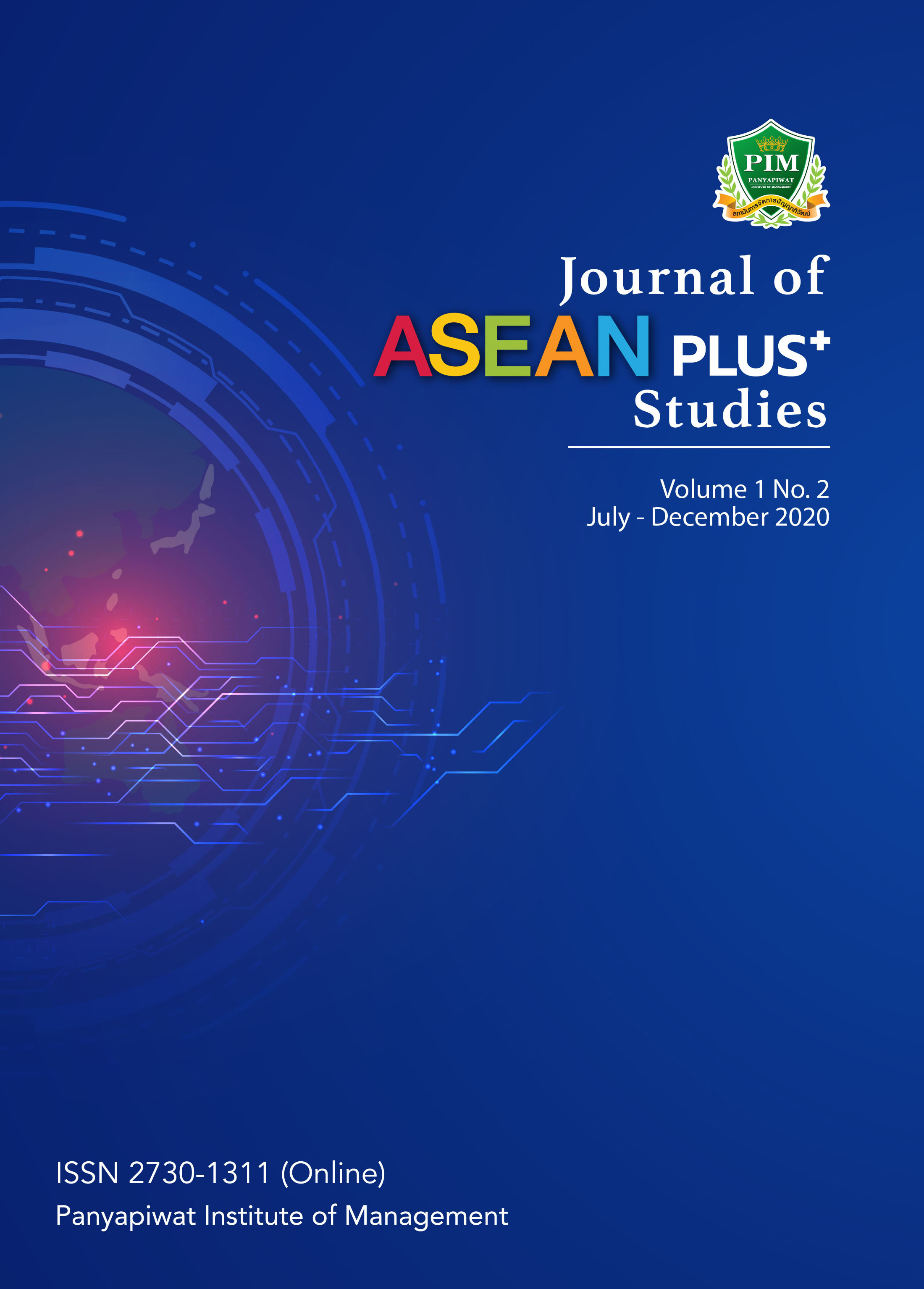Potential Structural Change of Labor Force from Corporate Perspectives
Keywords:
Labor Force, Artificial Intelligence, Corporate Perspectives, Structural Change, Labor MarketAbstract
Advanced technologies are key factors enhancing industrial and digital revolution. According to the upcoming of Artificial Intelligence (AI) in Thailand, there are concerns on the future works and job reallocation. The aim of this study is to determine the perceptions of businesses on the abilities of human labor and robots or AI, where different types of labors, human and AI, suit different types of job duties.The data retrieved from 74 observations of firms collected from senior managers in various industries throughout Thailand during August 2018 through survey questionnaires. The corporate domain covers entrepreneurs who offer customer services, logistics, reception, call center, security, and advice functions. The results show that the entrepreneurs trust AI and robotics more than human in many tasks, leaving just the logistics, which interaction with customers is needed in the digital society, still be dominated by humans. Theurity, cede position. digital transformation by AI willing th each other.urate and efficient at interpreting human' results imply that it is unavoidable for Thailand to move toward the digital transformation which human labor and advanced technologies will be combined to work together, and somehow advanced technologies may take over human jobs in many tasks. It is also the evidence implying that Thailand is fast enough, at lease on the entrepreneurial side seen from their perspectives and perceptions, in moving toward the digital economy. This evidence is a significant warning to human labor to equip themselves with interaction skills for the works that cannot be replaced by AI.
References
Acemoglu, D. & Restrepo, P. (2020). Robots and jobs: Evidence from us labor markets. Journal of Political Economy, 128(6), 2188-2244.
Anderson, J. & Smith, A. (2014). AI, Robotics, and the Future of Jobs. Technology Review, 16(4). Retrieved August 20, 2020, from https://www.pewresearch.org/internet/2014/08/06/future-of-jobs/
Atalay, E., Phongthiengtham, P., Sotelo, S., & Tannenbaum, D. (2018). New technologies and the labor market. Journal of Monetary Economics, 98(7), 48-67.
Benzell, S., Kotlikoff, L., LaGarda, G., & Sachs, J. (2015). Robots Are Us: Some Economics of Human Replacement. National Bureau of Economic Research, 2015(2), 6-55.
Bessen, J. E. (2017). AI and Jobs: The Role of Demand. SSRN Electronic Journal, 2018(1). Retrieved August 20, 2020, from https://papers.ssrn.com/sol3/papers.cfm?Abstract_id=3078715
Chui, M., Manyika, J., & Miremadi, M. (2016). Where machines could replace humans —and where they can’t (yet). McKinsey Quarterly, 2016(3). Retrieved August 20, 2020, from https://www.mckinsey.com/business-functions/mckinsey-digital/our-insights/where-machines-could-replace-humans-and-where-they-cant-yet#
Curtis, B. (2019). AI IN BUSINESS: KEY TRENDS, ADVANTAGES AND DISADVANTAGES. Retrieved December 5, 2019, from https://www.yourtechdiet.com/blogs/future-artificial-intelligence-business/
DeCanio, S. J. (2016). Robots and humans - complements or substitutes?. Journal of Macroeconomics, 49(9), 280–291.
Fortunati, L., Esposito, A., & Lugano, G. (2015). Introduction to the Special Issue “Beyond Industrial Robotics: Social Robots Entering Public and Domestic Spheres”. Information Society, 31(3), 1-13.
Gartner Inc. (2017). Newsroom. Retrieved December 5, 2019, from https://www.gartner.com/en/newsroom/press-releases/2017-12-13-gartner-says-by-2020-articial-intellingence-will-create-more-jobs-than-it-eliminates
Lee, Y. N. (2017). Robots ‘are here to give us a promotion’, not take away jobs, Gartner says. Retrieved August 20, 2020, from https://www.cnbc.com/2017/12/18/artificial-intelligence-will-create-more-jobs-than-it-ends-gartner.html
Manyika, J., Chui, C., Miremadi M., Bughin J., George, K., Willmott, P., & Dewhurst, M. (2017). A future that works: Automation, Employment, and Productivity. Retrieved August 20, 2020, from https://www.mckinsey.com/~/media/mckinsey/featured%20insights/Digital%20Disruption/Harnessing%20automation%20for%20a%20future%20that%20works/MGI-A-future-that-works-Executive-summary.ashx
Marr, B. (2020). The Top 10 Artificial Intelligence Trends Everyone Should Be Watching In 2020. Retrieved February 15, 2020, from https://www.forbes.com/sites/bernarmarr/2020/01/06/the-top-10-artificial-intelligence-trends-everyone-should-be-watching-in-2020/?sh=3677d0be390b
Mortensen, D. T. & Pissarides, C. A. (1998). Technological progress, job creation, and job destruction. Review of Economic Dynamics, 1(4), 733-753.
Nam, T. (2019). Citizen attitudes about job replacement by robotic automation. Futures, 109(5), 39–49.
Qureshi, M. O. & Syed, R. S. (2014). The impact of robotics on employment and motivation of Employees in the service sector, with special reference to health care. Safety and Health at Work, 5(4), 198-2020.
Social Tables. (2018). Robots in Hotels: 6 Hotel Brands Leading the Way. Retrieved January 10, 2019, from https://www.socialtables.com/blog/hospitality-technology/hotel-brands-robot/
Soonsarthorn, T. (2018). 4 upcoming technologies for AI in manufacturing industry. Retrieved August 30, 2018, from https://www.mmthailand.com/4เทคโนโลยีaiสายการผลิต/
Uzialko, A. (2019a). How Artificial Intelligence Will Transform Business. Retrieved May 5, 2020, from https://www.businessnewsdaily.com/9402-artificial-intelligence-business-trends.html
Uzialko, A. (2019b). Workplace Automation is Everywhere, and It’s Not Just About Robots. Retrieved May 15, 2020, from https://www.businessnewsdaily.com/9835-automation-tech-workforce.html
West, D. M. (2015). What happens if robots take the jobs? The impact of emerging technologies on employment and public policy. Centre for Technology Innovation at Brookings, 2515(10), 1-22.
Wolla, S. A. (2018). Will Robots Take Our Jobs?. Retrieved August 10, 2020, from https://research.stlouisfed.org/publications/page1-econ/2018/01/02/will-robots-takeourjobsutm_medium=email&utm_campaign=201801A+Research+Newsletter&utm_content=201801A+Research+Newsletter+CID_4bdb115ede04d3b253fd70439ded022e&utm_source=Research+newsletter&utm_term=Page+One+Economics






